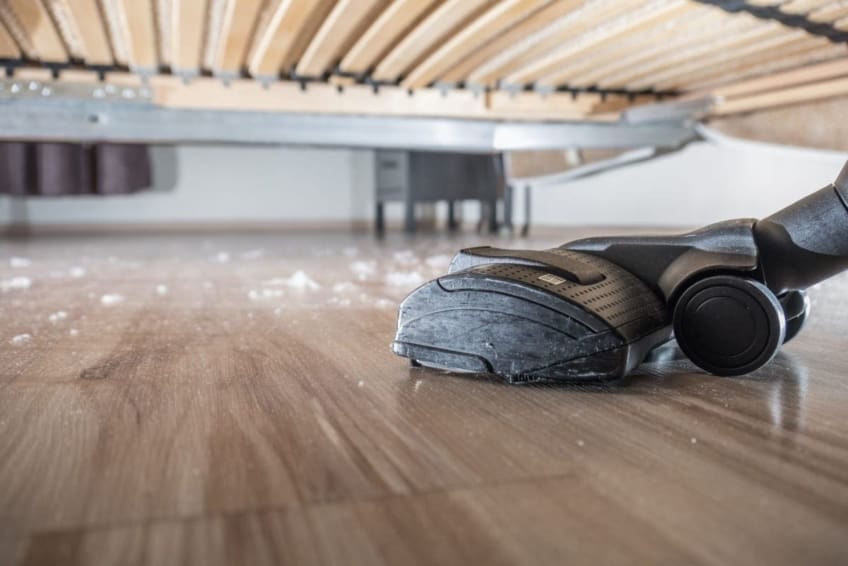
What are dust mites?
Dust mites are tiny bugs that make their way into our homes. They can cause allergic reactions in some people. They measure about 1/100th of an inch in length. That is smaller than the period at the end of this sentence. Dust mites feed off of pet and human dander (dead skin cells in the air and on surfaces in our homes). They live in every home in items such as mattresses and furniture.
Why are dust mites bad for me?
Dead skin and other waste from dust mites is a major cause of allergies and make asthma symptoms worse. Symptoms of dust mite allergy include sneezing, runny nose, itchy nose, and nasal congestion. If you have asthma, dust mites can cause you to wheeze more and need more asthma medicine. You may have more asthma symptoms at night, when you are lying in a bed infested with dust mites. Cutting down on the number of dust mites in the home is an important step if you or someone in your family has allergies or asthma.
It may not be possible to eliminate dust mites from your home entirely. The key is to minimize number and treat symptoms. There is no medical treatment for dust mites, just for the symptoms that they cause in people with allergies and asthma.
Path to Improved Wellness
Dust mites love warm, humid areas filled with dust. Bed pillows, mattresses, carpets, and furniture are great places for them to live. Cleaning each one of these places can reduce the number of dust mites in your home.
What do I do first to get rid of dust mites?
Start in the bedroom.
- Put a tightly woven, dust-proof cover over your mattress. Most of the dust mites in your house live in your mattress.
- Wash your sheets and blankets in very hot water once a week. The water should be 130°F to 140°F. Water over 120°F can burn children if they turn on the hot water by themselves, so you may not want to set your water heater at this temperature. If this is the case, you can wash your sheets and blankets at a commercial laundry.
- Wash your pillow every week or put a dust-proof cover on it. (The pillowcase goes over the cover.)
- Make sure you dry sheets, blankets, and pillows completely on high heat.
- Avoid carpeting. Dust mites can grow rapidly in carpet. If possible, your bedroom should have a hardwood, tile, or linoleum floor.
- Damp-mop any hard floor surfaces once a week.
- If you have carpet, try not to place it on concrete. The warm space between a rug and concrete is a good place for mites to live.
What else can I do?
- Vacuum your carpets, upholstery, and draperies every week.
- Use a vacuum with a high-efficiency filter. Special air filters may also help reduce dust mites in the air.
- Avoid miniblinds. Use vinyl window shades instead.
- Wash curtains, throw rugs, and blankets in hot water weekly.
- Avoid upholstered furniture. Plastic, wood, or leather furniture that doesn’t have much padding can help keep down the number of dust mites in your home.
- Reduce the amount of clutter in your home. Knick-knacks, books, and plants collect a lot of dust.
- Keep the humidity in your home low by using a dehumidifier. Keep it cool by running your air conditioner. Dust mites love warm, humid places.
- Use a damp cloth or rag to wipe surfaces where dust can collect weekly. This includes countertops, shelves, doorframes, and windowsills.
- If your children have allergies, make sure to buy them stuffed animals and toys that you can put in the washing machine.
Things to Consider
Can allergy medicine relieve my symptoms from dust mites?
Over-the-counter and prescription allergy medicines are available to help control your allergy symptoms.
If dust mites are making your asthma symptoms worse, or if you are taking more of your asthma medicine than usual, talk to your doctor. They may want you to switch to a new medicine that can better control your symptoms.
Questions to Ask Your Doctor
- Does everyone have dust mites?
- What are signs that I have a dust mite problem?
- Could my allergies be caused by dust mites?
- Can dust mites trigger an asthma attack?
- How can I get dust mites out of my home?
Resources
American Lung Association: Dust Mites
National Institute of Environmental Health Sciences: Dust Mites and Cockroaches
![]()
Copyright © American Academy of Family Physicians
This information provides a general overview and may not apply to everyone. Talk to your family doctor to find out if this information applies to you and to get more information on this subject.







